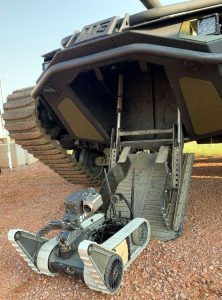
Providing mission systems to ground robots
Will there be more soldiers or more unmanned systems in a limited area in an urban warfare scenario? Tom Frost, FLIRs VP and General Manager of Unmanned Ground Systems and Integrated Solutions, first highlights the chaos that soldiers will face, especially in urban environments, the 3D nature of the threat, and the number of devices present in limited areas in the future battlefield. “The area will be loaded with cameras, laser scanners, chemical sensors, robots that are themselves loaded with those sensors, not to mention those operating at greater distances, all of them providing a huge amount of data, and we must think at how to make them useful to the warfighter,” Frost stresses.
The real issue is to provide the soldier with data that allow him to move quicker and make better decisions. “With Terabytes of information flowing per second on the battlefield, at best this flow is overwhelming, at worst it is completely distractive, and turns from an advantage into a disadvantage, distracting warfighters from their primary mission” he points out. For the US Army Robotic Combat Vehicle-Medium (RCV-M) programme Textron developed the Ripsaw M5, a 10.5 tonnes tracked UGV that may become for heavy armoured vehicles what the Loyal Wingman should be for fighters. FLIR is part of the Ripsaw team and is providing Textron with real time situational awareness systems which includes information processing as well as hardware, in the form of mast-mounted gimballed RSTA sensors, marsupial unmanned ground vehicles and tethered and untethered UAS.

“The M5 is an impressive system, entirely robotic, loaded with capabilities and with sensors of all kinds; it also has robots inside the robot, both airborne and ground, and it can detect thermal signatures at great distance, see 360° around the vehicle at all times, and in an instant it can launch a UAS and have a God’s eye perspective of the battlefield around it,” Frost says, adding that “these are super-human capabilities, the amount of information that can be collected by that suite of sensors and robots is something that is way beyond the ability of a human to process.” FLIR is working to solve that problem, “so we take data, turn them in information, and turn those information in insight that is actionable.” Strong algorithms are used to sort through that mass of data, as no human being will be ever able to process them in real time, to extract information and take a decision.
“On the Ripsaw M5 vehicle we are employing AI and machine learning to extract relevant information, i.e. when you are looking 360° or at long distance you don’t want to see how many individuals are identified or how many trucks are around, you want to know the threat.” FLIR is thus generating algorithms that allow to automatically identify individuals who carry weapons, classify military vehicles, in order to allow the warfighter to take the right decisions. Moreover the company is working on algorithms that can detect threats, can alert warfighters about suspicious behaviours, i.e. digging to plant an IED, can detect patterns of operation reporting where opponent’s patrols are, and can track targets,” Frost continues. All this to avoid information overload and analysis paralysis, and to allow the warfighter to act in the shortest possible time. The RCV-M prototype development is underway and we are quite advanced in testing the prototype. The delivery schedule is early 2021 for the initial systems to go through an evaluation and experimentation with the US Army.
Photos courtesy FLIR



